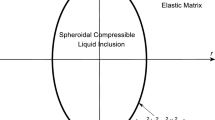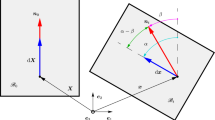Abstract
When a rod of gel is deflected in 3-point bending, two types of relaxation process occur: hydrodynamic relaxation caused by flow of liquid within the gel network, and viscoelastic relaxation of the network itself. The kinetics of load relaxation have previously been analyzed for the case of hydrodynamic relaxation within a perfectly elastic network. That analysis describes, for example, the behavior of silica gel in a nonreactive solvent, such as acetone. When the liquid can attack the gel network, then true viscoelastic relaxation is superimposed on hydrodynamic relaxation, and that situation is examined in the present paper. To a very good degree of approximation, the total relaxation is equal to the product of the hydrodynamic and viscoelastic relaxation functions. In Part II, it will be shown that the present analysis describes the behavior of silica gel in an aqueous solvent and in an alcohol/amine solution.
Similar content being viewed by others
References
C.J. Brinker and G.W. Scherer, Sol-Gel Science (Academic Press, NY, 1990).
G.W. Scherer, J. Non-Cryst. Solids, 113, 107–118 (1989);
G.W. Scherer and R.M. Swiatek, J. Non-Cryst. Solids 113, 119–129 (1989).
G.W. Scherer, H. Hdach, and J. Phalippou, J. Non-Cryst. Solids 130, 157–170 (1991); correction 136, 269 (1991).
G.W. Scherer, J. Non-Cryst. Solid 142 [1–2], 18–35 (1992).
G.W. Scherer, “Relaxation of a Viscoelastic Gel Bar: II. Silica gel,” Proc. Int Workshop on Glasses and Ceramics from Gels, to be published in J. Sol-Gel Science and Technology 2 [1–3], (1994).
G.W. Scherer, Relaxation in Glass and Composites (Wiley, New York, 1986).
M.A. Biot, J. Appl. Phys. 33 [4], 1482–1498 (1962).
G.W. Scherer, J. Non-Cryst. Solids 109, 171–182 (1989).
L.J. Gibson and M.F. Ashby, Cellular Solids (Pergamon Press, New York, 1988), p. 129.
F.B. Hildebrand, Methods of Applied Mathematics, 2nd ed. (Prentice-Hall, Englewood Cliffs, NJ), p. 175.
G.W. Scherer, J. Non-Cryst. Solids 109, 183–190 (1989).
J. DeBast and P. Gilard, Phys. Chem. Glasses 4 [4], 117–128 (1963).
G.W. Scherer, J. Am. Ceram. Soc. 69 [5], 374–381 (1986).
IMSL Math/Library, Version 1.1, IMSL Inc., 2500 City West Blvd. Houston, TX 77042-3020, USA.
Author information
Authors and Affiliations
Rights and permissions
About this article
Cite this article
Scherer, G.W. Relaxation of a viscoelastic gel bar: I. theory. Journal of Sol-Gel Science and Technology 1, 169–175 (1994). https://doi.org/10.1007/BF00490246
Issue Date:
DOI: https://doi.org/10.1007/BF00490246




